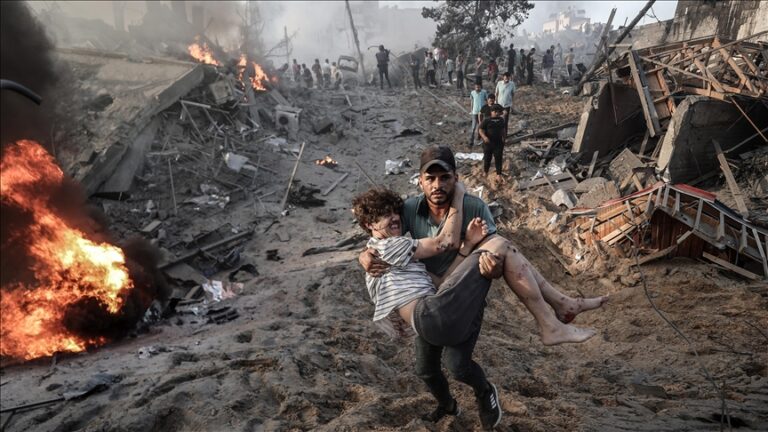
As the war between Israel and Hamas heats up, the Gaza Strip is dealing with one of its worst humanitarian crises as of April 22, 2025. With intensifying military actions, a complete siege, and growing civilian casualties, the situation has quickly gotten worse.
Escalation of Military Operations
Israel began one of its largest airstrike attacks in recent weeks on April 22, striking many locations throughout Gaza. At least 17 Palestinians, including women and children, were killed in these strikes, which also destroyed about 40 pieces of heavy equipment—including bulldozers—that were necessary for rescue efforts and had been supplied by mediators like Egypt and Qatar.
In Khan Younis, a particularly horrific incident claimed the lives of nine people, including four children. Additional strikes in Jabaliya and Nuseirat further exacerbated the civilian casualty toll. Local health officials say more than 51,000 Palestinians have been murdered since the battle began in October 2023, while Israel says 20,000 of those killed were militants.
Humanitarian Catastrophe Amid Blockade
Since March 2025, Gaza has been completely cut off, depriving the region of necessities like food, water, medication, and gasoline for more than 50 days. The World Health Organisation has warned of an imminent healthcare collapse as a result of the severe shortages caused by this embargo. Many youngsters are now at risk of avoidable illnesses as a result of the suspension of a U.N.-backed polio vaccination campaign that was meant to vaccinate over 600,000. Furthermore, malnutrition is already manifesting in 60,000 children.
Additionally, 75% of U.N. missions in Gaza have been denied or delayed due to the siege, which has hindered humanitarian work. The health system is overburdened and only partially operational, and medical supplies are dangerously inadequate. Families are left without access to clean water, shelter, and quality healthcare, increasing the risk of illness and death every day.
Civilian Casualties and Targeted Attacks
There have been other incidents during the conflict that have resulted in large civilian casualties. At least 35 Palestinians, including women and children, were killed and more than 70 others were injured in an Israeli airstrike that struck a residential structure in a highly populated district of Shuja’iyya, Gaza City, on April 9. Eight homes were demolished in the raid, and over 20 people went missing. The high number of civilian casualties has prompted international outrage, despite Israel’s claims that the strike targeted a senior Hamas commander..
Another terrible incident occurred on April 16, when Israeli airstrikes killed Palestinian photojournalist Fatma Hassona and eleven family members. A documentary on Hassona, who gained notoriety for recording civilian life during the Gaza War, was chosen for the Cannes Film Festival in 2025.
International and Regional Responses
The growing issue has caused great alarm among the international community. Humanitarian groups, including the Palestine Red Crescent Society and the United Nations, have denied Israeli allegations that the March murders of 15 medical personnel were the result of “professional failures,” accusing Israel of unlawfully killing and targeting designated rescue convoys.
The goal of Egypt’s postwar restoration plan for Gaza is to rehabilitate the region by 2030 without forcing its citizens to relocate. The plan calls for the removal of more than 50 million tonnes of debris and explosive munitions, the construction of temporary dwellings, and the deployment of an international peacekeeping force. In favour of this idea, the Arab League has called for international assistance and the creation of a trust fund administered by the World Bank to aid in restoration efforts..
Domestic Unrest and Protests
There have been several rallies in Gaza as a result of dissatisfaction with Hamas. People have protested against Hamas’s rule in places like Jabaliya, Beit Lahia, Gaza City, and Khan Younis, yelling “Hamas are terrorists” and “We want to live.” Growing dissatisfaction among Gazans, who blame Hamas for the ongoing fighting and humanitarian situation, is reflected in these protests.
Global Solidarity Movements
Global solidarity movements have been triggered by the suffering of Palestinians in Gaza. The “March for Gaza” in Dhaka, Bangladesh, on April 12 drew some 100,000 participants who called for an end to Israeli military operations and urged nations with a majority of Muslims to cut their connections with Israel. Similar to this, on April 13, tens of thousands of people participated in the “Gaza Solidarity March” in Karachi, Pakistan, which was coordinated by Jamaat-e-Islami with assistance from other political and civil society organisations. In response to Israeli violence, these protests demanded a statewide strike on April 22.
Prospects for Resolution
A Hamas delegation is visiting Cairo to negotiate a possible long-term truce as part of ongoing diplomatic efforts. A five- to seven-year truce, the evacuation of Israeli soldiers from Gaza, and the exchange of Palestinian captives for all Israeli hostages are among the proposals. Israel, meanwhile, insists that any deal must entail the return of all captives and the dissolution of Hamas.
The prolonged conflict in Gaza continues to have a devastating impact on the civilian population. To ensure the peace and security of the region, immediate international engagement is essential to halting hostilities, facilitating humanitarian aid, and paving the path for a durable conclusion.



